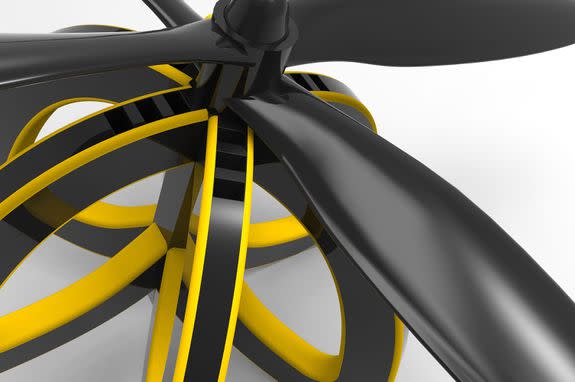This pollinating bee drone shows the powers of these endangered creatures

Bees in the U.S. are more endangered than ever, requiring protection under the Endangered Species Act for the very first time back in October.
Now a college student in Georgia is showing the world just how environmentally vital these creatures really are — by creating a bee drone that pollinates flowers.
SEE ALSO: National Geographic's 'Origins' is like 'Cosmos' but about the nature of human civilization
Anna Haldewang, a 24-year-old senior at the Savannah College of Art and Design, created a black and yellow device called Plan Bee as a design project for a class.
It's a single prototype that's made out of foam, plastic and a set of propellers that takes it into the air. When you flip the hand-sized drone upside down, it looks like a flower with six little sections that mimic petals. Those sections each contain tiny holes that the drone uses to suck in pollen. From there, the drone stores that pollen and later releases it during cross-pollination.

Image: courtesy of Savannah College of Art and Design
For now, Haldewang's design project hasn't been mass-produced or marketed. But she has high hopes for the prototype. Since her invention does all the great things a real-life bee does, it could one day be used as an educational tool for humans.
"I would love to see people use it in their backyards and even create custom gardens with it," Haldewang told CNN. "With an actual bee, it's so small you don't notice it and how it's pollinating flowers. With the drone you can see how the process works."
The pollination that bees do is essential for flowers receiving the nutrients they need and, thus, for the food chain to continue functioning properly. And there's some pretty important environmental benefits to this routine process of nature. For one, pollinated flowers release breathable oxygen into the air during photosynthesis. Aside from this cleaner air, the flowering plants also help water and soil in some pretty cool ways.
"Flowering plants help to purify water and prevent erosion through roots that holds the soil in place," states the U.S. Department of Agriculture website, adding that the actual foliage of these plants offers a buffer that protects the ground during heavy rainfall.
This isn't the first time the magical pollinating abilities of bee has been mimicked by robots. Just days ago, the results of a Japanese study about bee drones were published in the academic journal Chem.
Haldewang, an industrial design student, first came up with the idea to make an artificial bee when her professor assigned a project that needed to be self-sustainable and help the growth of plants.
Right now the Plan Bee drone may be seen as more of an educational tool, but that could change one day, according to Victor Ermoli, dean of the Savannah College of Art and Design.
"The design is self-explanatory and it offers a very clever solution," he told CNN. "It could conceivably be used in large-scale farming, even in hydroponic farming."
